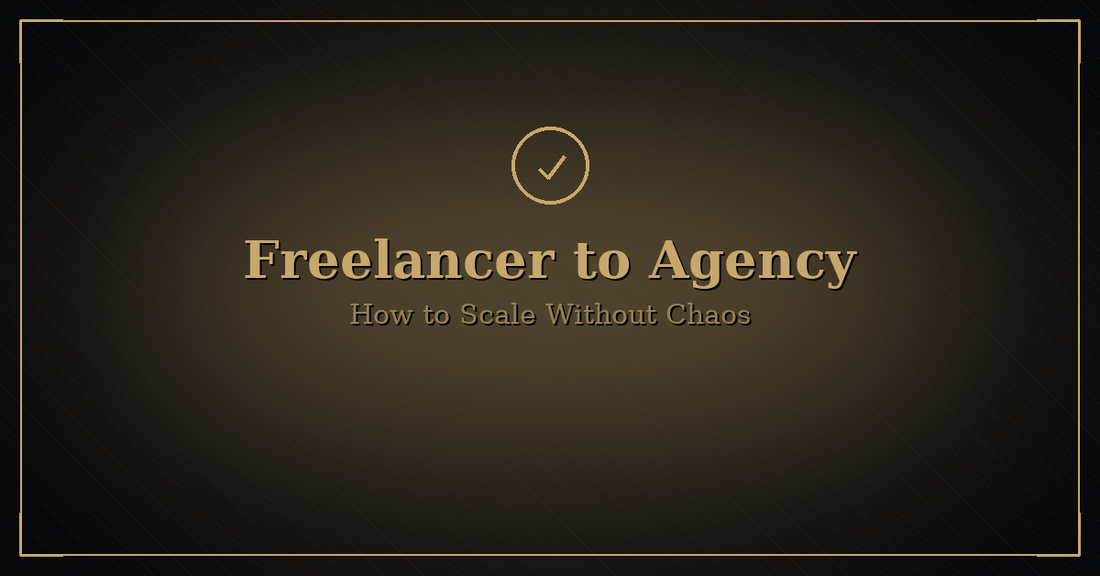
Freelancer to Agency: How to Scale Without Chaos
Share
Freelancer to Agency: How to Scale Without Chaos
Growing from freelancer to agency is not about doing more work. It’s about doing the same work the same way, so quality stays high while capacity increases. The freelancers who scale calmly don’t chase bigger projects first; they make their offer crystal clear, turn delivery into a rhythm, then add people and process where the work already flows.
Step 1: Turn your service into a clear offer
Agencies are built on productized services—a defined outcome, a timeline, a price, and visible edges. Write your offer in one sentence a busy client can repeat: who it’s for, what result they get, and by when. Publish what’s included every time, what is outside scope, and a small remedy if you miss a deadline. This clarity reduces revisions, protects margin, and makes handoffs to teammates easier.
Step 2: Run the work on a weekly rhythm
Chaos sneaks in when everyone delivers differently. Put delivery on rails: the same steps, in the same order, every week. In plain language, create SOPs (standard operating procedures) as short checklists: kickoff, first draft, review, final pass, delivery. Add a simple client onboarding page that sets expectations—how to send inputs, how feedback works, when deliverables arrive. When your process is visible, clients relax and your team can execute without guesswork.
Step 3: Price for margin and capacity
Scaling a freelance business requires pricing that leaves room for help. Think in contribution margin: price minus the direct costs to deliver (specialist time, tools you only need for the project). Aim for services to keep ≥60% contribution so you can pay teammates and still profit. Watch your utilization rate (the percentage of time spent on paid work vs. admin). If utilization drops below 60–70% for weeks, tighten scope, reduce meetings, or streamline approvals. Good pricing protects standards; bad pricing forces shortcuts.
Step 4: Hire in the right order, with proof
Don’t hire a crowd—hire bottlenecks. Your first additions are usually:
a specialist who does the core work to your spec, and
a project coordinator who protects timelines and communication.
Use one-page role scorecards (outcomes, responsibilities, boundaries) and paid trial projects before long contracts. Keep your SOPs in front of new hires from day one, and require a short “what I did / what’s next / risks” update after each milestone. Clear roles and small trials prevent expensive mis-hires.
Step 5: Make the pipeline predictable
Agencies that last rely on retainers and a steady trickle of new work. Offer a standard retainer with reserved slots and a sensible SLA (response window, not “unlimited”). For new leads, pick one acquisition channel you can sustain—referrals with a small thank-you, a focused newsletter, or ranking for one buyer keyword at a time. It’s better to own one small channel than dabble in five.
Common pitfalls (and how to avoid them)
The first pitfall is vagueness: unclear scope leads to rework and margin leaks. Fix it by writing edges and add-on prices. The second is hero culture: everything depends on one person; when they’re busy, quality dips. Fix it by using checklists and pairing roles. The third is too many custom offers: custom work breaks your rhythm. Fix it by standardizing 80% and quoting the unusual 20% as a separate add-on.
A simple 30/60/90 plan
Days 1–30: finalize a productized service; publish edges and a remedy; write SOP checklists; move three active clients onto the new process.
Days 31–60: run the weekly rhythm; measure turnaround times and revisions; adjust scope or price to hit your contribution target. Start a small retainer with two best-fit clients.
Days 61–90: add one specialist via a paid trial; offload recurring steps; document what changed; begin one reliable acquisition channel (referrals or one SEO topic cluster).
The quiet markers of a real agency
You’ll know you’ve moved from freelancer to agency when delivery is on time without heroics, when clients know the next step without asking, when your contribution margin holds even as you add capacity, and when new teammates produce work you can ship with minimal edits. That’s scale without chaos.
Cross-promo: Systems & Scaling
If you want the full, step-by-step playbooks, Systems & Scaling takes this further. It covers productized offers, SOPs in plain English, capacity planning, hiring with role scorecards and trials, and a weekly operating rhythm that keeps standards high while you grow. It’s a practical guide to turning a solid freelance service into a durable, calm agency.
